Apr
2021
The Investment Case for Online Retail
DIY Investor
11 April 2021
Introduction
 Online retail has permanently disrupted the traditional brick-and-mortar store retail landscape as “clicks” have replaced “bricks.” According to research firm eMarketer, global ecommerce is expected to exceed $3.9 trillion this year[1], providing online retailers fertile ground to grow their business in this new era of contactless shopping.
Online retail has permanently disrupted the traditional brick-and-mortar store retail landscape as “clicks” have replaced “bricks.” According to research firm eMarketer, global ecommerce is expected to exceed $3.9 trillion this year[1], providing online retailers fertile ground to grow their business in this new era of contactless shopping.
In the United States, ecommerce sales were projected to reach $794.5 billion in 2020, a 32.4% increase over 2019, versus previous forecasts of 18% growth.[2] The global coronavirus pandemic accelerated the pace of ecommerce growth in 2020, propelling online sales to levels not previously expected until 2022—helping existing online retailers expand their dominance in retail.
Value-added features such as competitive pricing, shopping convenience, greater product selection and rapid delivery options have solidified online commerce as a disruptive technology that is here to stay.
Ever-increasing internet and mobile penetration is one of the key drivers contributing to this growth, enabling more consumers to shop online anywhere and anytime.
New technological innovations in electronic payment, rapid delivery, artificial intelligence and voice-assisted shopping, as well as virtual and augmented reality continue to enhance the online shopping experience, further driving the expansion and growth of this investment theme.
Additionally, due to the pandemic in 2020, digital commerce added new shoppers that had not previously shopped online, fuelling new buying habits such as online grocery, which grew 43%.[3]
This trend has accelerated traditional retail’s woes, with 27 U.S. retailers having filed for bankruptcy as of September 2020, on the heels of 17 major retailer bankruptcies in 2019, pre-pandemic.[4] Amid this marketplace evolution, online retail has become a transformational and dominant force in global retail.
A Brief History of Online Retail
Online commerce has permanently transformed the retail sector and the way consumers and businesses shop for everything—from books to office supplies, to shoes and furniture. But how did it all begin?
The origins of online commerce pre-date the internet age. Indeed, the first predecessor of online commerce was the mail-order catalogue. In the 1970s, protocols such as Electronic Data Interchange (EDI) and Electronic Funds Transfer (EFT) were created, providing the infrastructure needed to support electronic transactions.
In 1979, the British inventor Michael Aldrich [2] was credited with being the official “inventor of ecommerce.” Aldrich connected a television and a telephone line and invented “teleshopping” or shopping at a distance.
Meanwhile in the United States, infomercials (paid television advertisements) gained popularity, paving the way for the first cable home shopping channels. Finally, the internet came along and changed the way we shop forever.
See below a brief timeline highlighting some of the historical milestones that cleared the path for modern day e-retail commerce:
“The mall isn’t dead, it has just moved online.”
– EQM Indexes
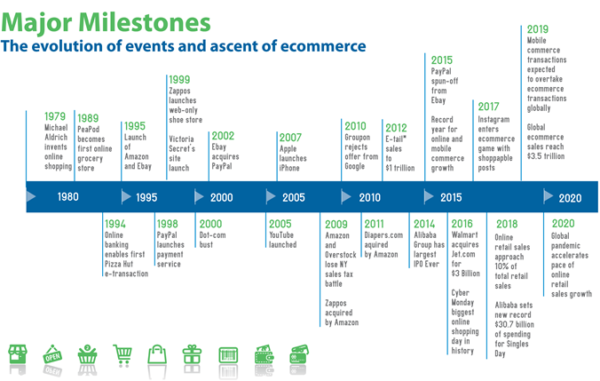
For illustrative purposes only Source: EQM Indexes
Value Proposition
A number of key benefits serve as the driving forces behind the growth of ecommerce. These benefits have proven to be valuable for businesses, consumers and society as a whole.
| Business | Consumer | Society |
| Lower costs associated with not having a physical presence | Enhanced product selection | Less traffic and crowds |
| Automated inventory management | No geographic sourcing boundaries | Price competition and democratization of selection |
| Customer analytics | Competitive pricing, virtual auctions | Expanded access to rural areas |
| Unlimited geographic presence | Convenience of shopping from home/office/ mobile device 24/7/365 | Shopping and delivery access for housebound consumers |
| Open for business
24/7/365 |
Time savings for consumers, one-stop shopping | Facilitated delivery of public services, such as education and health care |
| Reduced advertising and marketing costs | Customer reviews and social input | Global in scope |
Source: EQM Indexes
Growing Global Opportunity
Given the superior benefits online and virtual commerce provide, it is no wonder that this channel has grown at a superior pace than traditional retail. U.S. ecommerce sales now represent 14.0% of total retail sales, after declining slightly from its pandemic lockdown peak in the second quarter of 2020.[5]
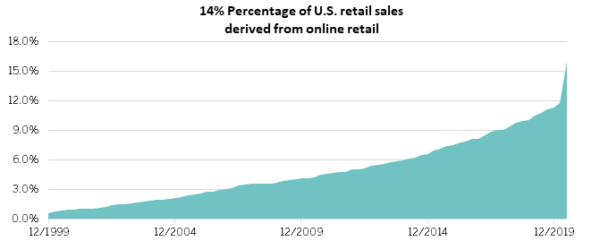
For illustrative purposes only Source: U.S. Department of Commerce Quarterly Retail Ecommerce Sales, 2nd Quarter 2020, reported 8/18/2020.
Globally, ecommerce is also growing at a rapid pace, with year-over-year percentage growth of 27.6% in 2020, with sales approaching $4.3 trillion in 2020, up from $3.3 trillion in 2019, according to eMarketer. By 2022, it is forecasted that ecommerce’s percentage of total retail sales worldwide will surpass the 20% mark. [6]
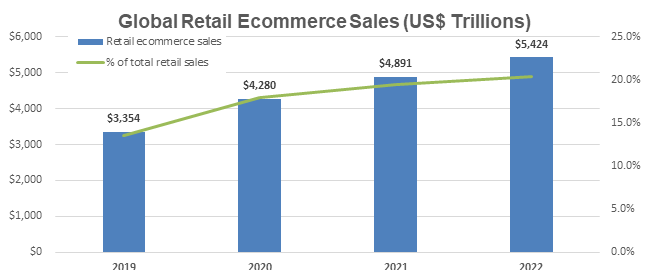
For illustrative purposes only Source: eMarketer, December 2020.
While U.S. online retail sales comprise only 14% of total retail sales, other large ecommerce markets such as the United Kingdom and China have a much higher proportion of online-to-total retail sales. In addition to the U.S. market, here are some of the other top global markets for ecommerce:
China – China is the world’s biggest ecommerce market led by companies such as Alibaba Group and JD.com and sites such as Taobao, TMall and others, with retail ecommerce sales penetration of 44.8% in 2020.[7] With an annual growth rate last year of 27.5%, China’s ecommerce market is also one of the fastest growing. In 2020, driven by popular sales events like Alibaba’s Singles Day, the world’s largest 24-hour shopping event which generated $115 billion in record sales alone[8], China’s ecommerce sales totaled almost $2.3 trillion.
United Kingdom – Despite its small size, the United Kingdom is a big player in the area of ecommerce, securing third position with $180 billion in annual sales. Amazon UK, eBay UK, Asos, Currys PC World, Gumtree, Argos and John Lewis are some the U.K.’s biggest ecommerce sites[9]. Moreover, the country has one of the highest ecommerce sales percentages at 30.9% of total retail sales in 2020.
Japan – The fourth largest ecommerce player in the world, Japan is the leading mobile commerce (m-commerce) player. Rakuten, Mercari, and Yahoo! Japan are some of Japan’s leading ecommerce platforms. Annual online sales are $141 billion, and it ranks among the fastest-growing globally, boosted by a developed economy, highly urbanized population, 93% internet penetration and single-language culture. Japan’s ecommerce businesses also benefit from the small country size and excellent infrastructure, allowing for rapid delivery.[10]
Germany – Germany is Europe’s second largest ecommerce market with $97 billion in sales in 2020, behind the United Kingdom. Amazon has a good foothold in the German market, similar to the U.K. market. eBay also has a large presence in Germany.
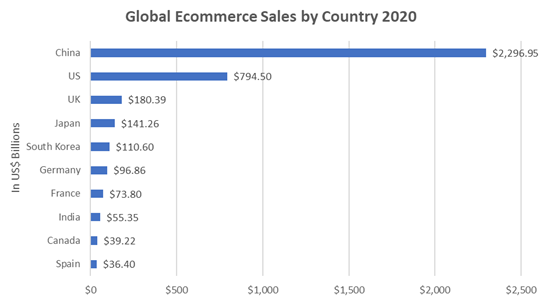
For illustrative purposes only Source: eMarketer, Dec 2020
Ecommerce has emerged as a global shopping phenomenon. From Cyber Monday to Singles Day, here are some of the year’s busiest online shopping days around the world.
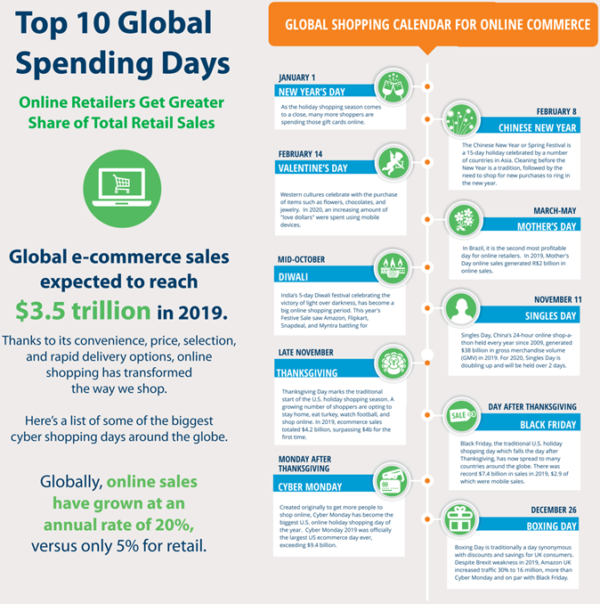
Expanding Internet and Mobile Penetration
Mobile commerce sales reached $2.8 trillion in 2020, an increase of 32% over the $2.1 trillion registered in 2019.[11]
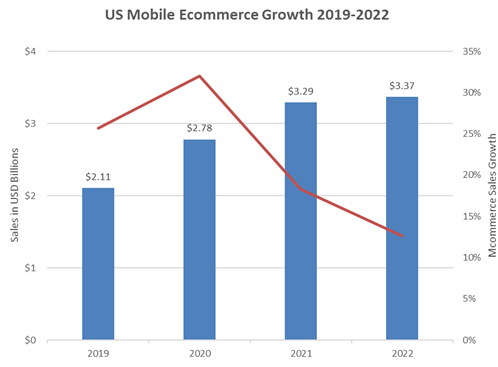
For illustrative purposes only Source: Bloomreach, Statista, RedSeer, Alibaba, Adobe Analytics, SimilarWeb
Bigger screens, engaging mobile shopping applications and secure payment options have helped encourage mobile commerce growth. Mobile has exploded as a shopping channel, not just from a traffic standpoint, but in terms of sales and dollar growth. Mobile commerce is expected to account for more than half of ecommerce by the end of 2021.[12]
More than 63.2% of the world now has access to the internet[13] and the opportunity set has rapidly expanded with broad availability worldwide, thanks to smart mobile devices allowing consumers to shop online anywhere, anytime.
The growth of mobile ecommerce in China, now $873.3 billion in market size, is a prime example of mobile commerce’s potential.[14] China’s more than 1 billion WeChat users can make purchases on their smartphones using WeChat Pay without leaving the messaging and social commerce platform. More than 18% of these mini-program sites are devoted to ecommerce.[15] China generated $268 billion in social commerce sales in 2020.[16]
Brands, retailers and ecommerce can design a customer-user interface with pictures, videos and GIFs to increase user engagement. These mini-program stores provide access to customer data and promote organic sharing, reducing new customer acquisition costs. For example, Chinese e-retailer Pinduoduo utilizes group-buying promotions to encourage sharing among customers.
Technological Innovation
While mobile penetration is a big driver of current online retail growth, future technological innovations such as seamless and secure methods of electronic payment, voice-assisted shopping, virtual and augmented reality and artificial intelligence will take the online shopping experience to the next level and further drive market expansion.

+ Electronic Payments
Many consider the Uber and Lyft models as the proverbial “gold standard” for invisible payment that digital commerce players want to replicate. In the future, payment will be something that just happens seamlessly in the background without much thought or input from the consumer. As a nation of smartphone users, China has quickly adopted digital- wallet brands such as Alibaba’s Alipay and Tencent’s WeChat Pay, which are now used to pay for the majority of their ecommerce purchases.
+ Voice-Assisted Shopping
Thus far in 2020[ND1] , 50% of all searches in the United States have been voice searches and voice shopping is estimated to reach $40 billion in the United States by 2022, with almost 75% of households owning a smart speaker by 2025.[17] Almost two-thirds of voice-enabled speaker owners such as the Amazon Echo and Google Home devices, already have purchased items via voice commerce.[18] But these devices also have “push” capabilities, making recommendations based on past purchases or customer data.
+ Virtual and Augmented Reality
Virtual and augmented reality is another promising growth driver as online shopping aims to marry the “real-life” shopping experience with the convenience of ecommerce on mobile devices. Already, consumers can use their smartphones to visualize product purchases like furniture in their home.
+ Artificial Intelligence
Accounting for an impressive 35% of its overall sales revenue, artificial intelligence (AI) product upselling and cross-selling on Amazon’s ecommerce platform, is a major success story. AI is also being used in ecommerce for providing chatbot customer service, analyzing customer comments, and personalized shopping services. Research firm Gartner predicted that 80% of all online customer interactions will be managed by AI technologies by year-end 2020.[19]
Despite the recent acceleration of online commerce spurred by the global pandemic, online retail still makes up a relatively small part of total retail sales at 14%, per the latest statistics for 2020. However, nearly all growth in retail sales came from online sales, which was up 32.1% year-over-year through December 31, 2020, versus a gain of 6.9% for total retail sales.[20]
Research firm eMarketer forecasts that global retail ecommerce sales will grow 17.1% in 2021, generating $4.9 trillion in ecommerce sales. Latin America was the fastest growing ecommerce market in 2020, as the pandemic had a profound impact on Latin America’s retail industry. Mandated stay-at-home orders in several countries like Brazil and Argentina forced retailers to close physical stores.
Ecommerce sales in Argentina grew 79% in 2020, followed by 71% in Singapore and 36% in Spain.
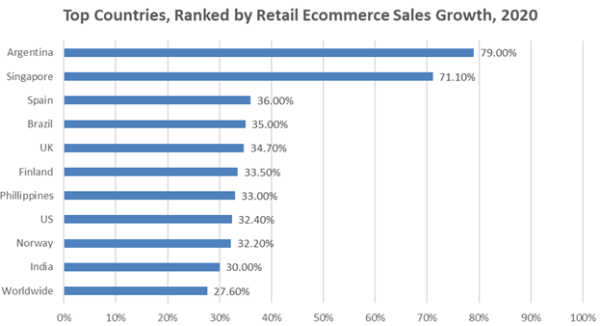
For illustrative purposes only Source: eMarketer, Dec 2, 2020
Explicit exposure to ecommerce retail may provide investors with access to superior growth characteristics than traditional brick-and-mortar retail holdings. A universe of global online retail stocks, as represented by the EQM Global Online Retail Growth Index, exhibits better long-term earnings growth estimates than traditional retail indices.
Over the last five years, the investment performance of the EQM Global Online Retail Growth Index relative to traditional retail indexes has also been superior, reflecting this surging earnings and sales expansion.
Global Online Retail vs. Retail: 5-Year Performance
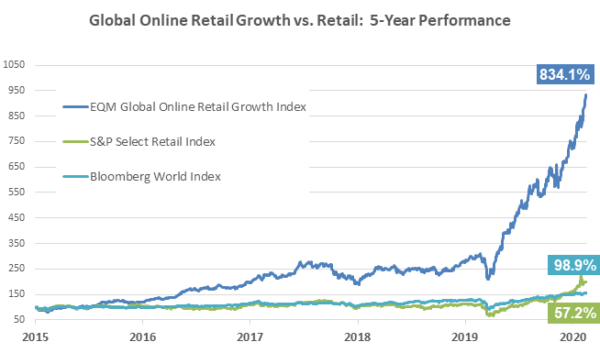
Performance before inception is based on back tested index data. Back testing is the process of evaluating an investment strategy by applying it to historical data to simulate what the performance of such strategy would have been.
Back tested data does not represent actual performance and should not be interpreted as an indication of actual or future performance. Past performance for the index is in USD. Past performance is not an indicator for future results and should not be the sole factor of consideration when selecting a product.
Investors should read the prospectus of the Issuer (“Prospectus”) before investing and should refer to the section of the Prospectus entitled ‘Risk Factors’ for further details of risks associated with an investment in this product. Source: EQM Indexes. Data as of 15.02.2021
Online shopping is expected continue growing at a fast clip globally, given the continued expansion of internet access and mobile penetration, as well as the introduction of new technological innovations that will further enhance the online shopping experience. Furthermore, the pandemic has accelerated the pace of growth and consumer adoption of new channels such as online grocery and e-fitness.
Over the past year, the bifurcation in retail between the brick-and-mortar traditional retailers, “the bricks” and online retailers, “the clicks,” has been quite pronounced. Retail bankruptcies have skyrocketed over the last few years, being coined the “retail apocalypse.”[21] Starting in 2010 until today, numerous brick-and-mortar retail stores, especially those of large chains worldwide, have been forced to close.
In 2019, 17 major retailers filed bankruptcy and retailers closed more than 9,500 stores. In 2020, retailers have faced even tougher challenges as the COVID-19 outbreak caused many retail establishments to temporarily shutter, keeping customers away, forcing retailers to negotiate with landlords and suppliers to tackle unforeseen inventory and liquidity issues.
30 U.S. Retailers Filed for Bankruptcy in 2020[22]:
- Century 21 (Sept. 10)
- Stein Mart (Aug. 12)
- Tailored Brands (Aug. 2)
- Lord & Taylor (Aug. 2)
- Ascena (July 23)
- The Paper Store (July 14)
- RTW Retailwinds (July 13)
- Muji USA (July 10)
- Sur La Table (July 8)
- Brooks Brothers (July 8)
- G-Star Raw (July 3)
- Lucky Brand (July 3)
- GNC (June 23)
- Tuesday Morning (May 27)
- Centric Brands (May 18)
- J.C. Penney (May 15)
- Stage Stores (May 11)
- Aldo (May 7)
- Neiman Marcus (May 7)
- J. Crew (May 4)
- Roots USA (April 29)
- True Religion (April 13)
- Modell’s Sporting Goods (March 11)
- Art Van Furniture (March 9)
- Bluestem Brands (March 9)
- Pier 1 (Feb. 17)
- SFP Franchise Corp (Jan. 23)
In 2017, a Business Insider report dubbed this phenomenon as the “Amazon Effect”, calculating that Amazon.com was generating more than 50% of the growth in retail sales.[23] Amazon’s global ecommerce sales are expected to reach $416.5 billion in 2020, up 20.2% from 2019, as consumers rely even more heavily on ecommerce due to COVID-19.[24]
However, there is recent evidence that as the pandemic has pushed many more consumers online, they are not all going to Amazon, to the benefit of other sites.[25]
The broader theme in play is the transformation from the physical world to the virtual world, a theme that is not limited to retail and has impacted other sectors and industries. Below are some of the biggest beneficiaries of this theme:
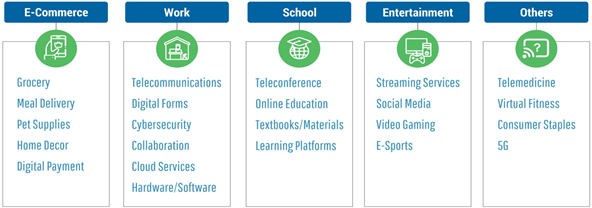
Source: EQM Indexes
One could argue, as consultant Deloitte does, that the retail apocalypse is really a retail “renaissance.”[26] A renaissance upends many of the ideas and conceptions that have long governed human behaviour, uprooting traditions, institutions and habits of thought. The rapid growth and expansion of retail ecommerce has led many to proclaim “the mall is dead.”
But we see it differently. The renaissance of retail in online shopping offers consumers a wider selection of merchandise, better prices, and a superior level of convenience. The mall isn’t dead, it has just moved online.
Conclusion
In our view there are many reasons to own a basket of global stocks directly focused on online retail sales:
- Get explicit investment exposure to the fastest growing global segments of online commerce: online retail, online marketplace and online travel.
- Participate in the exciting growth potential fuelled by the technological innovation driving the “retail renaissance.”
- Gain access to the online-retail growth opportunities worldwide
Global Online Retail UCITS ETF IBUY
EQM Global Online Retail UCITS ETF (IBUY) is a UCITS compliant exchange traded fund domiciled in Ireland. The fund seeks to provide exposure to the rapidly growing online e-commerce market as competitive pricing, shopping convenience, greater product selection and rapid delivery have made online shopping a disruptive technology that continues to exhibit strong growth characteristics, gain market share, and expand globally. IBUY is a passive, rules-based fund provide exposure to global companies that derive significant revenue from direct online retail, marketplace and online travel. The index is revenue weighted with a maximum of 20% exposure to Emerging Markets

Risks
Investors’ capital is fully at risk and investors may not get back the amount originally invested The value of equities and equity-related securities can be affected by daily stock and currency market movements Exchange rate and interest rate fluctuations could have a negative or positive effect on returns.
Visit the Global Online Retail UCITS ETF Fund Page
Click here to download the IBUY investment case
[1] Global Ecommerce 2020, eMarketer, June 22, 2020, https://www.emarketer.com/content/global-ecommerce-2020
[2] US Ecommerce Growth Jumps to More than 30%, Accelerating Online Shopping Shift by Nearly 2 Years, eMarketer, October 12, 2020,
[3] Koetsier, John, 44% Of Global eCommerce Is Owned By 4 Chinese Companies, Forbes, October 21, 2020, https://www.forbes.com/sites/johnkoetsier/2020/10/21/44-of-global-ecommerce-is-owned-by-4-chinese-companies/?sh=547230a21645 [4] The running list of 2020 retail bankruptcies, Retail Dive, September 14, 2020, https://www.retaildive.com/news/the-running-list-of-2020-retail-bankruptcies/571159/
[5] US Census Bureau, Quarterly Retail E-Commerce Sales 4th Quarter 2020, February 19, 2021, https://www2.census.gov/retail/releases/historical/ecomm/20q4.pdf
[6] Cramer-Flood, Ethan, Global Ecommerce Updated 2021, eMarketer, January 13, 2021, https://www.emarketer.com/content/global-ecommerce-update-2021
[7] eMarketer, December 2020.
[8] Kharpal, Arjun, Alibaba, JD set new records to rack up $115 billion of sales on Singles Day, CNBC, November 12, 2020. https://www.cnbc.com/2020/11/12/ singles-day-2020-alibaba-and-jd-rack-up-record-115-billion-of-sales.html
[9] Top 10 Ecommerce Sites in the UK, 2019, https://ecommerceguide.com/top/top-10-ecommerce-sites-in-the-uk/
[10] Gillani, Amyn, Japan: An Overlooked E-Commerce Opportunity, April 6, 2020, https://www.entrepreneur.com/article/348787
[11] Mobile Commerce Sales 2020, eMarketer
[12] Brandt, Ari, How the pandemic transformed mobile apps into the new storefront, February 17, 2021. https://www.digitalcommerce360.com/2021/02/17/how-the-pandemic-transformed-mobile-apps-into-the-new-storefront/
[13] Internet World Stats, 2020 Q4 Estimates, https://www.internetworldstats.com/stats.htm
[14] Ecommerce payment trends: China, 2019 JP Morgan Global Payment Trends,
[15] Chu, Franklin. Why China ecommerce is going crazy for WeChat mini-programs, April 16, 2019, Digitalcommerce360, https://www.digitalcommerce360.com/2019/04/16/why-china-ecommerce-is-going-crazy-for-wechat-mini%E2%80%91programs/
[16] eMarketer, January 2021.
[17] Kinsella, Brett, Loup Ventures Says 75% of U.S. Households Will Have Smart Speakers by 2025, Google to Surpass Amazon in Market Share, June 18, 2019, https://voicebot.ai/2019/06/18/loup-ventures-says-75-of-u-s-households-will-have-smart-speakers-by-2025-google-to-surpass-amazon-in-market-share/
[18] Shukairy, Ayat. The State of Voice Shopping – Statistics and Trends, Invesp, https://www.invespcro.com/blog/voice-shopping/
[19] How Artificial Intelligence is transforming the E-commerce Industry, Countants, May 9, 2019, https://medium.com/@Countants/how-artificial-intelligence-is-transforming-the-e-commerce-industry-countants-scalable-custom-73ae06836d35
[20] https://www2.census.gov/retail/releases/historical/ecomm/20q4.pdf
[21] Retail Apocalypse, Wikipedia, last edited October 26, 2020, https://en.wikipedia.org/wiki/Retail_apocalypse
[22] Retail Dive, September 24, 2020
[23] Taylor, Kate, One statistic shows how much Amazon could dominate the future of retail, Business Insider, November 1, 2017, https://www.businessinsider.com/retail-apocalypse-amazon-accounts-for-half-of-all-retail-growth-2017-11
[24] Droesch, Blake, Amazon’s worldwide sales will rise 20.2% this year as reliance on e-commerce grows, Business Insider, July 9, 2020, https://www.businessinsider.com/amazon-global-ecommerce-sales-will-reach-416-billion-in-2020-2020-7
[25] David, Don, Amazon’s share of US online retail revenue dips slightly in Q3, November 3, 2020, Digital Commerce 360, https://www.digitalcommerce360.com/2020/11/03/amazons-share-of-us-online-retail-revenue-dips-slightly-in-q3/
[26] The great retail bifurcation, Deloitte Insights, 2018, https://www2.deloitte.com/content/dam/insights/us/articles/4365_The-great-retail-bifurcation/DI_The-great-retail-bifurcation.pdf
Contact
HANetf Ltd, City Tower, 40 Basinghall St,
London, EC2V 5DE
The price of any Shares or the value of an investment in ETPs may go up or down and an investor may not get back the amount invested. Past performance is not a reliable indicator of future performance. This material is not intended to be relied upon as a forecast, research or investment advice, and is not a recommendation, offer or solicitation to buy or sell any financial instrument or product or to adopt any investment strategy. Any decision to invest should be based on the information contained in the appropriate prospectus and after seeking independent investment, tax and legal advice.
These products may not be available in your market or suitable for you. The content of this document does not constitute investment advice nor an offer for sale nor a solicitation of an offer to buy any product or make any investment.
Commentary » Exchange traded products Commentary » Exchange traded products Latest » Latest » Mutual funds Commentary
Leave a Reply
You must be logged in to post a comment.